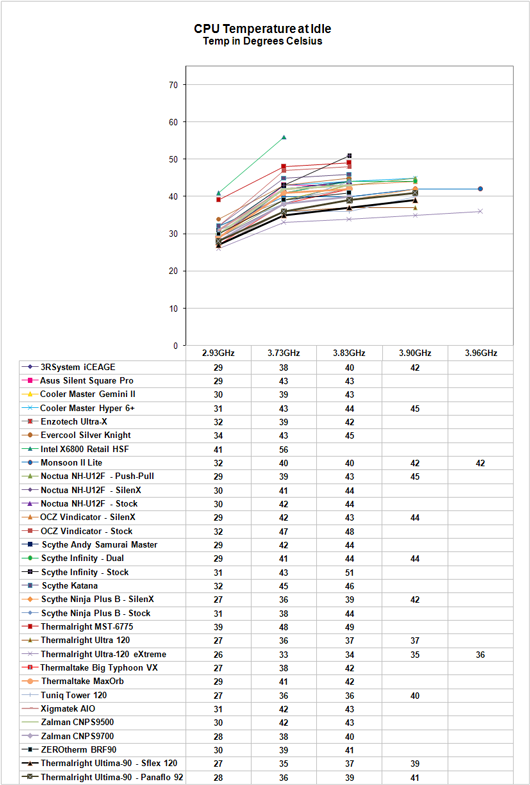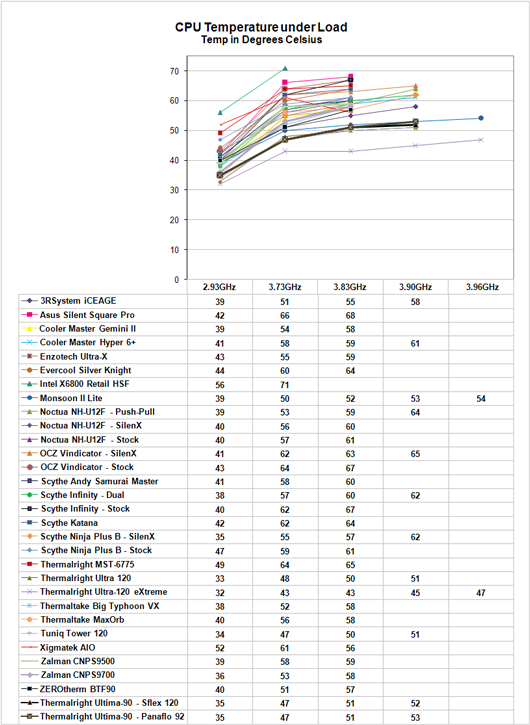Thermalright Ultima-90: Small Wonder?
by Wesley Fink on August 20, 2007 2:00 AM EST- Posted in
- Cases/Cooling/PSUs
Scaling of Cooling Performance
The Ultima-90 performance was top-of-the-line at both stock idle and stock load compared to other top air coolers tested at AnandTech. Excellent performance at stock speeds is one thing, but we were interested in seeing how this smaller, lighter Thermalright scales in cooling higher overclocks. The Ultima-90, to put it short and sweet, is a fierce competitor at higher speeds.
At 2.93GHz the retail HSF is running at 41C, compared to 27C with the Ultima-90/120. This is a delta of 14C. The delta generally becomes greater with the better heatsinks as the overclock increases. At 3.73GHz idle the retail HSF is 56C compared to the Ultima-90 at 35C - a delta of 21C. The cooling performance of the Ultima-90 is significantly better than the Intel retail cooler at idle. The Thermalright Ultima-90 also closely mirrors the best air performance ever measured with this X6800 CPU.
Looking closely at the curves of the top coolers tested, the Ultima-90 is almost a shadow curve for the Tuniq 120 and the Thermalright Ultra-120. This is true with either the 92mm or 120mm test fan. At the very top the 120mm fan squeezes out a bit higher overclock, but the results are otherwise identical. Considering the Ultima-90 is smaller, lighter, and cheaper than the coolers it matches in performance, the Ultima-90 a very attractive choice.
We also need to compare cooling efficiency of the Ultima-90 under load conditions to the retail HSF and other recently tested CPU coolers. Load testing can be very revealing of a cooler's efficiency. A basically flat line, particularly form 3.73GHz upward, indicates the cooler is still in its best cooling range. A line that is increasing rapidly indicates a cooler nearing the end of its ability to cool efficiently. Lines which parallel the best coolers over a range of values are indicate that the coolers have similar cooling efficiency.
The Ultima-90 is very efficient in cooling in the 2.93 GHz to 3.83 GHz overclock range. It then continues on to a highest overclock of 3.90GHz with the 120mm Scythe S-FLEX fan or 3.870GHz with the 92mm Panaflo. The Ultima-90 matches the top coolers tested in performance. The only air cooler that outperforms the Ultima-90 is the Thermalright Ultra-120 eXtreme, which is larger, heavier, and more expensive. We expected good performance and cooling at high overclocks with the Ultima-90, particularly after discussing the design philosophy with Thermalright. However, we did not really expect performance so close to their flagship eXtreme.
As stated many times, the overclocking abilities of CPUs will vary at the top, depending on the CPU. This particular CPU does higher FSB speeds than any X6800 we have tested, but the 3.90GHz top speed with the Tuniq is pretty average among the X6800 processors we have tested with Tuniq cooling. A few of the other processors tested with the best air coolers reach just over 4 GHz, but the range has been 3.8 to 4.0GHz. Stock cooling generally tops out 200 to 400 MHz lower, depending on the CPU, on the processors tested in our lab.
The Ultima-90 performance was top-of-the-line at both stock idle and stock load compared to other top air coolers tested at AnandTech. Excellent performance at stock speeds is one thing, but we were interested in seeing how this smaller, lighter Thermalright scales in cooling higher overclocks. The Ultima-90, to put it short and sweet, is a fierce competitor at higher speeds.
 |
| Click to enlarge |
At 2.93GHz the retail HSF is running at 41C, compared to 27C with the Ultima-90/120. This is a delta of 14C. The delta generally becomes greater with the better heatsinks as the overclock increases. At 3.73GHz idle the retail HSF is 56C compared to the Ultima-90 at 35C - a delta of 21C. The cooling performance of the Ultima-90 is significantly better than the Intel retail cooler at idle. The Thermalright Ultima-90 also closely mirrors the best air performance ever measured with this X6800 CPU.
Looking closely at the curves of the top coolers tested, the Ultima-90 is almost a shadow curve for the Tuniq 120 and the Thermalright Ultra-120. This is true with either the 92mm or 120mm test fan. At the very top the 120mm fan squeezes out a bit higher overclock, but the results are otherwise identical. Considering the Ultima-90 is smaller, lighter, and cheaper than the coolers it matches in performance, the Ultima-90 a very attractive choice.
We also need to compare cooling efficiency of the Ultima-90 under load conditions to the retail HSF and other recently tested CPU coolers. Load testing can be very revealing of a cooler's efficiency. A basically flat line, particularly form 3.73GHz upward, indicates the cooler is still in its best cooling range. A line that is increasing rapidly indicates a cooler nearing the end of its ability to cool efficiently. Lines which parallel the best coolers over a range of values are indicate that the coolers have similar cooling efficiency.
 |
| Click to enlarge |
The Ultima-90 is very efficient in cooling in the 2.93 GHz to 3.83 GHz overclock range. It then continues on to a highest overclock of 3.90GHz with the 120mm Scythe S-FLEX fan or 3.870GHz with the 92mm Panaflo. The Ultima-90 matches the top coolers tested in performance. The only air cooler that outperforms the Ultima-90 is the Thermalright Ultra-120 eXtreme, which is larger, heavier, and more expensive. We expected good performance and cooling at high overclocks with the Ultima-90, particularly after discussing the design philosophy with Thermalright. However, we did not really expect performance so close to their flagship eXtreme.
As stated many times, the overclocking abilities of CPUs will vary at the top, depending on the CPU. This particular CPU does higher FSB speeds than any X6800 we have tested, but the 3.90GHz top speed with the Tuniq is pretty average among the X6800 processors we have tested with Tuniq cooling. A few of the other processors tested with the best air coolers reach just over 4 GHz, but the range has been 3.8 to 4.0GHz. Stock cooling generally tops out 200 to 400 MHz lower, depending on the CPU, on the processors tested in our lab.










38 Comments
View All Comments
Wesley Fink - Monday, August 20, 2007 - link
The performance of the stock Intel Retail cooler also needs to be put in perspective. In our testing the Intel Retail HSF is stable to 3.73GHz at 1.50V. That translates into about 137W with an X6800 CPU.While early Intel Retail 775 coolers were very noisy, stock coolers since late Presller and through Core2 have been very quiet, as you can see in our noise measurements in reviews.
With a stock cooler performing this well, we think a cooler HAS to provide performance better than Intel Stock to persuade you to buy it. We could argue using your logic that the difference between the Intel stock of 3.73GHz and the top 3.94GHz is only 200 megahertz and so it is minor. The wattage difference, however, is between 137W and 166W, which is a significant difference in the ability of coolers to dssipate heat.
ssiu - Monday, August 20, 2007 - link
I have a serious question regarding this. 3.73Ghz is perfectly fine with me and I don't care for another 200Mhz. The louder noise of stock cooler is also okay with me. So that leaves the temperature difference of 71C for stock cooler versus (43C for Ultra-120 eXtreme, 47C for Ultima-90, 59C for NinjaB, 62C for Infinity, etc.) Does the stock cooler's higher temperature make the CPU die prematurely? Or is it a case of "the CPU is designed to withstand 71C; at 3.73Ghz, 71C may make it last 5 years instead of 10 years at 43C, but even at 71C it will become obsolete (too slow) before it will die"?Wesley Fink - Monday, August 20, 2007 - link
Intel shows a maximum recommended temp of 60.4C at 75W (stock) for the X6800 in their thermal design document at ftp://download.intel.com/design/processor/datashts...">ftp://download.intel.com/design/processor/datashts... However, 3.83 Ghz is about 137W and we really don't know the recommendations at these higher frequencies since they represent overclocks.It would seem reasonable to aim for lower than the max recommended temperature at stock speed if you are aiming for longevity of the CPU. That cahart can be found on p.85 of the Intel PDF linked above.
Wesley Fink - Monday, August 20, 2007 - link
Correction - 3.73GHz at 1.5V is about 135W - which is the max stable speed with the Intel stock HSF. Sorry for the typo.Jedi2155 - Monday, August 20, 2007 - link
To Coolerman:I had the Tuniq 120 for about 6 months on my E6600 setup, and although it was a great cooler and signifcantly cheaper than the Ultra 120 Extreme, it just isn't as good when all things are considered (size, noise levels, fan options) and the Ultra 120 extreme is worth the price difference IMO. The size made installation ever so much easier than the Tuniq and improvement in cooling (even with a cheap $7 thermaltake fan) was significant (went from 80 C Intel TAT to around 70 C).
I definitely think that you should recategorize the coolers, but instead of temperature, how about price range or probably best category SIZE.
I've had a number of issues during builds for friends, where the a certain cooler wouldn't fit (like a Tuniq 120 or the Ultra 120 Extreme) fit inside a case without significant modification (with a pair of pliers and remove a good section of the case).
That should help us decide better than just pure temperatures and overclock speed.
CZroe - Monday, August 20, 2007 - link
I think that sorting by value/prices is a bad idea. Have you looked for the actual prices? Anandtech's reported suggested prices and "actual" market prices have been FAR lower than I've been able to find in each cooler that interested me. I eventually just settled on the Ultra-120 Extreme and the same fan from Newegg and paid FAR too much.Perhaps the observed difference is because they keep getting price results for similar models (which complicated my own searching) or the only places that still carry some of these still have them because they always overcharged.
tom0099 - Friday, August 6, 2021 - link
http://google.com">googletom0099 - Friday, August 6, 2021 - link
<a href="https://google.com">google</a>